To catch carp, you first have to find them. These freshwater fish prefer murky, warm water with plenty of vegetation. You must bring proper equipment, tackle, baits, and lures too. Carp spook easily, so approach them carefully and consider using a rod pod.
Do you want to learn how to catch carp? Carp fishing is full of challenges and can test the skills of even pro fishermen.
I have had the luck of learning from carp angling experts. They have given me a number of excellent carp fishing tips that helped me score bigger fish with less effort. So, if you want to get started with carp fishing, stay tuned!
Know Your Enemy: The Carp
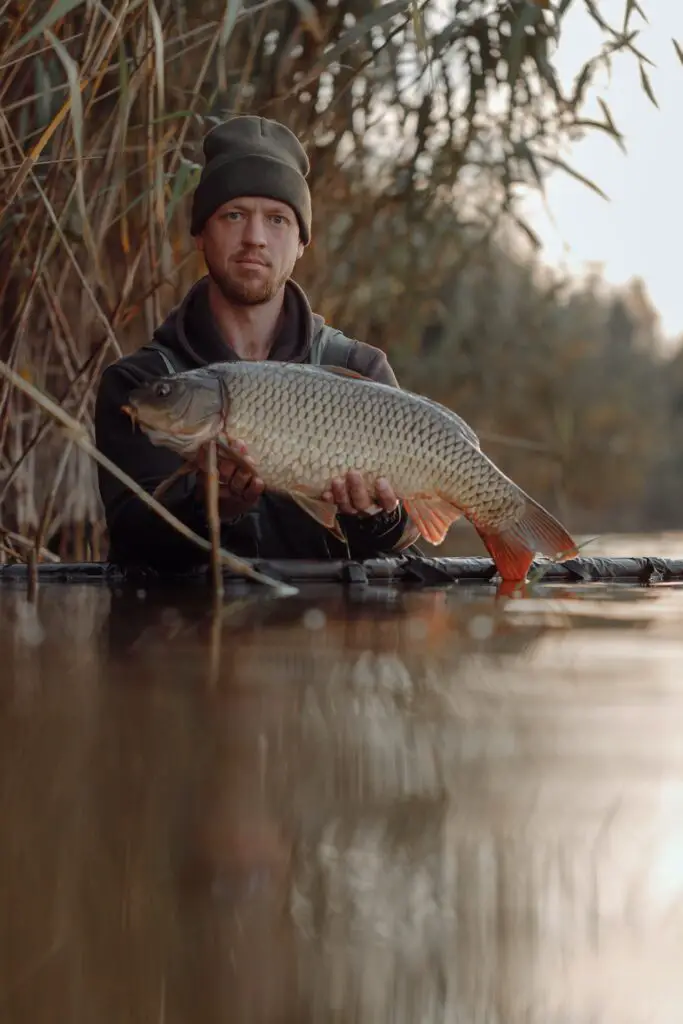
The common carp (Cyprinus carpio) is a widely cultured freshwater fish species native to Europe and Asia. Carp species belong to the family Cyprinidae and are also known as bony fish (Osteichthyes). They were first introduced to the USA in the 1800s.
Common carp can live in most conditions in rivers, lakes, and ponds. They can handle temperatures ranging from 3 to 35°C (37.4 – 95°F,) but the ideal temperature for their growth and reproduction is between 20 and 25°C (68 – 77°F).
These hardy fish have a round or oval body, reddish or yellowish belly, long dorsal fin with 2-3 hard rays, and a forked tail. They also have characteristic barbels around their large mouth – one pair on their upper lip and the other at the corners.
Common carp bodies are covered in scales. There are four different types of scaliness by which you can differ scaly carp, mirror carp, leather carp, and frame or linear carp. Their color varies from green to silvery grey or even bronze, depending on where they live and what subspecies they belong. Mirror carp have distinctive, large, and mirror-like golden scales.
As far as size is concerned, an average carp is up to 31.5 inches long and 4.5-31 lbs in weight. However, there are huge carp that can weigh from 20-60 lbs, which are caught from time to time. I have had the pleasure of scoring a 30 lb big carp once too.
Common carp are bottom feeders that prefer the lower sections of the water column. Their ideal habitat is shallow water with a muddy bottom. Carp spend a lot of their time digging in the soil in search of water insects. Therefore, if you find a murky and overgrown spot, you’ll likely find carp too.
Depending on where they live, common carp spawn from late spring until early summer. These fish can have as many as two or three spawning periods per year. Unfortunately, only about 1 percent of hatched eggs survive long enough to become adult fish. For this reason, people have developed various propagation techniques.
Interesting fact:
Carp belong to the minnow family, which makes them closely related to goldfish.
The Best Carp Fishing Tips & Tricks
If you want to overcome all the challenges of carp angling and catch carp quickly and with minimal effort, make sure you go through the following tips.
How To Find Carp
As I have already mentioned, carp prefer murky, warm water with dense aquatic vegetation. They are very apprehensive when they find themselves in clear water.
The International Game Fish Association has issued a few pieces of advice on how to locate carp, too. According to them, carp are most often found searching for food close to the shoreline. You should look for them near underwater structures, reed beds, and lilies, or in side channels and backwaters.
What about the season and time of the day?
In North America, fall is the prime season for carp fishing. At this time of the year, the water temperatures start dropping and carp begin their feeding frenzy in preparation for the long winter that follows. Your chances of scoring a big fish are the best at this period, too.
As far as the time of the day is concerned, you should get to your favorite carp fishing spot early in the morning or late in the afternoon. Try to get there as early as possible so that you can scan the calm water and find the distinct muddied areas created by fish movement.
The video below should help you find the ideal carp fishing spot:
Choosing The Best Bait
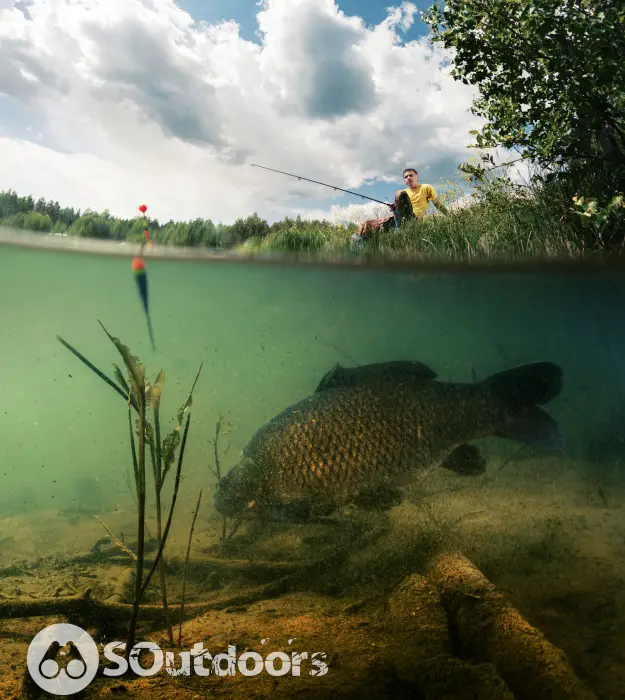
Carp are omnivorous and a species that can adapt to almost any environment they are introduced to. Choosing bait for carp should not be too difficult since they are known to eat everything from plankton and larvae to insects and weeds.
I often use hard-boiled bait or boilies on a hair rig to catch carp since their smell drives them wild. They tend to attract large fish, which is a bonus. However, there is a theory that carp can learn to associate boils with danger in heavily fished areas and start avoiding them. If that is the case, you can always resort to one of many other carp baits.
For example, carp love sweet corn. Moreover, sweet corn is budget-friendly and easy to use. Most carp anglers buy canned sweetcorn and thread the kernels directly onto the hook. You can also use maize when targeting larger fish on a large body of water. It does require some preparation before you can use it, but it offers many benefits. For example, it doubles as a loose feed and a hook bait.
Bread is an excellent bait for targeting carp and has a long tradition, too. My dad used to catch buckets of bigger carp using bread baits only. The video below will teach you how to use bread for carp fishing:
The American Carp Society also recommends using shrimps, snails, freshwater clams, mussels, beetles, and a variety of larvae since that is what carp eat in their natural habitat. It is always best to locate already feeding fish and introduce your bait. This way, you can see if your choice of bait yields results or not and adjust your tactics accordingly. The easiest way to do this is to use a fish finder.
Setting Up The Rod & Reel
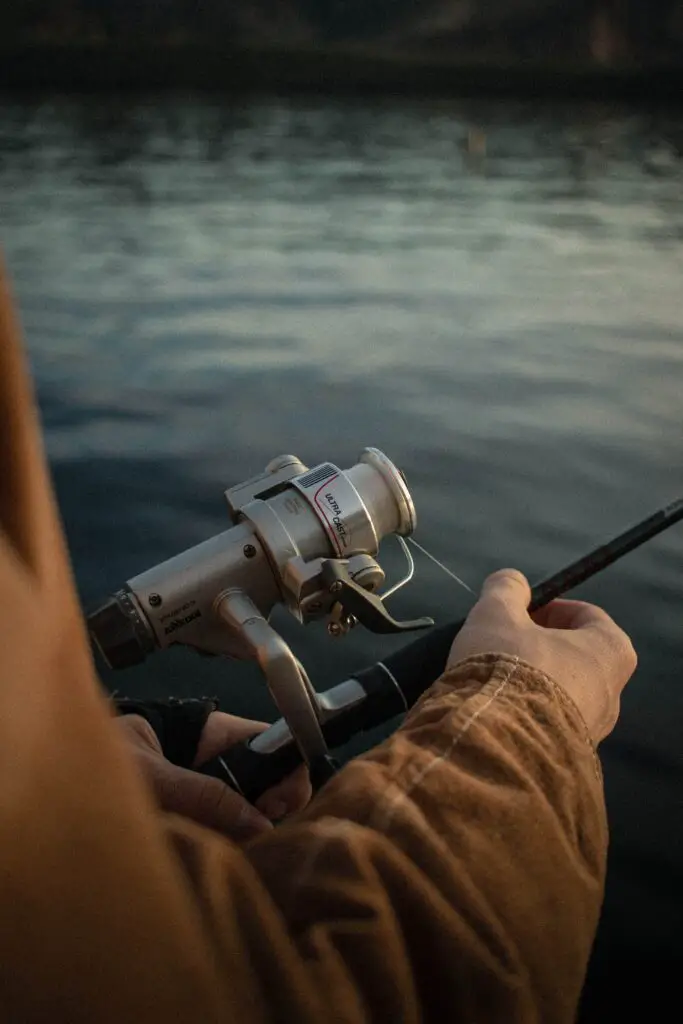
It is time to choose the best rod and reel combo for carp fishing. When fishing for carp in rivers, you should use a rod from 4 to 6 feet long, as you will mostly do short-distance casting. Such rods allow you to pull out these hard-fighting fish from tight spaces and thick underwater vegetation. If trying to catch carp in a large body of water, opt for a longer 8-13 ft rod. It is a much better choice for long-distance casting.
As far as the fishing reel is concerned, a bait-feeder spinning reel with two drag systems is one of the best choices. I personally use the Shimano Baitrunner, and it has brought me a lot of success.
If you are searching for a good beginner-friendly carp fishing rod and reel combo, check out the video below:
Selecting Fishing Line
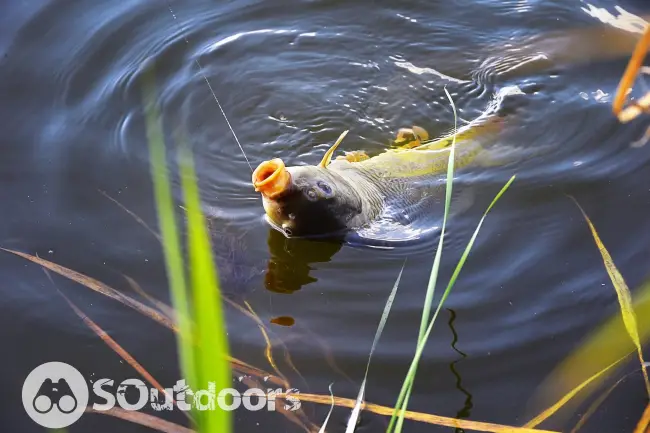
You can always use good-old supple monofilament fishing line. It sinks rather quickly if the current is not too strong and is quite forgiving too, which makes it suitable for beginner anglers.
There are two other options, though. When targeting bigger fish at close range, you can use a braided line. It has zero stretchiness and is ultra-durable. A fluorocarbon line is the best choice for targeting carp in clear water since it sinks well and is almost invisible.
When it comes to line test weight, there is one simple rule you should remember: the heavier the test weight, the better. Do not go below a 30 lb. test line.
Choosing The Appropriate Hook
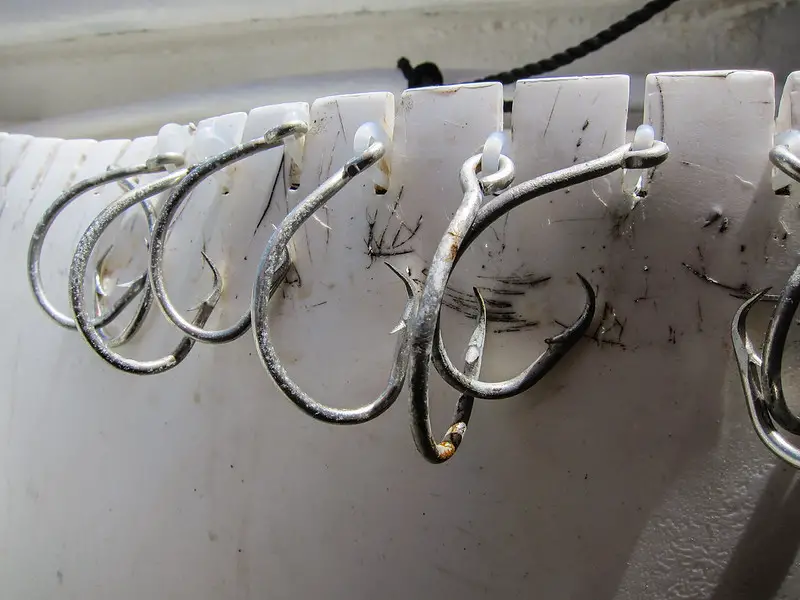
Image Credit: Flickr
Carp have immaculate eyesight, so most anglers avoid using shiny hooks and choose camouflaged or dark fishing hooks instead. If you use pop-ups or you are surface fishing, you should best use a wide gape hook. When bottom fishing, opt for a long shank pattern. If you are trying to hook a wary carp, try using a curved shank hook.
Using A Rod Pod
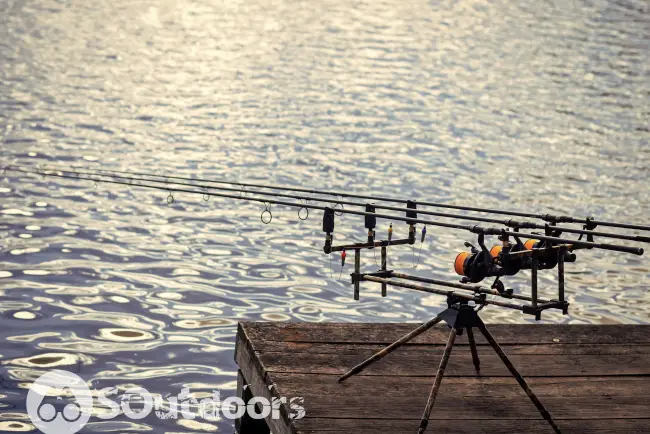
As I have already said, catching carp brings a lot of challenges, most of all because these fish spook easily. For this reason, many anglers resort to using a rod pod or a rod holder to eliminate inevitable movement along their fishing line and improve their hook rate.
Rod holders have a few additional benefits. First off, they eliminate fatigue during longer fishing sessions. They also enable anglers to position their rods at a precise angle, allowing the line to unspool with minimal resistance.
I have one more good reason to use rod pods! You have only two hands, but you can purchase as many rod holders as you want and set up multiple rigs at once, increasing your chances of catching fish.
If you are considering buying a rod pod, check out the one reviewed in the following video:
Chumming The Water
When I want to draw carp, I chum the water. Most anglers will give you the same advice, but chumming techniques might differ. I usually throw in a few handfuls of boilies into the water where carp feed since I’m already using them as bait. You can use bread crumbs or corn too. Alternatively, you can fill a dissolvable bag with chum and attach it to your rig.
No matter what method you choose to chum the water, moderation is the key. You do not want to overfeed carp. If their stomachs are full, carp will have no reason to bite your bait.
To learn more about chumming the water, watch the video below.
Using A Hair Rig
An effective hair rig (approved as International Game Fish Association IGFA-compliant) is highly popular among carp fishing enthusiasts. This rig takes advantage of carp’s natural feeding patterns.
When a fish eats your bait, the hook turns and pierces its bottom lip. This means you can remove it quite easily when practicing catch and release. There are many variants of the hair rig these days, depending on the hook length or material.
To learn how to tie a hair rig, watch the video below:
Bow Fishing
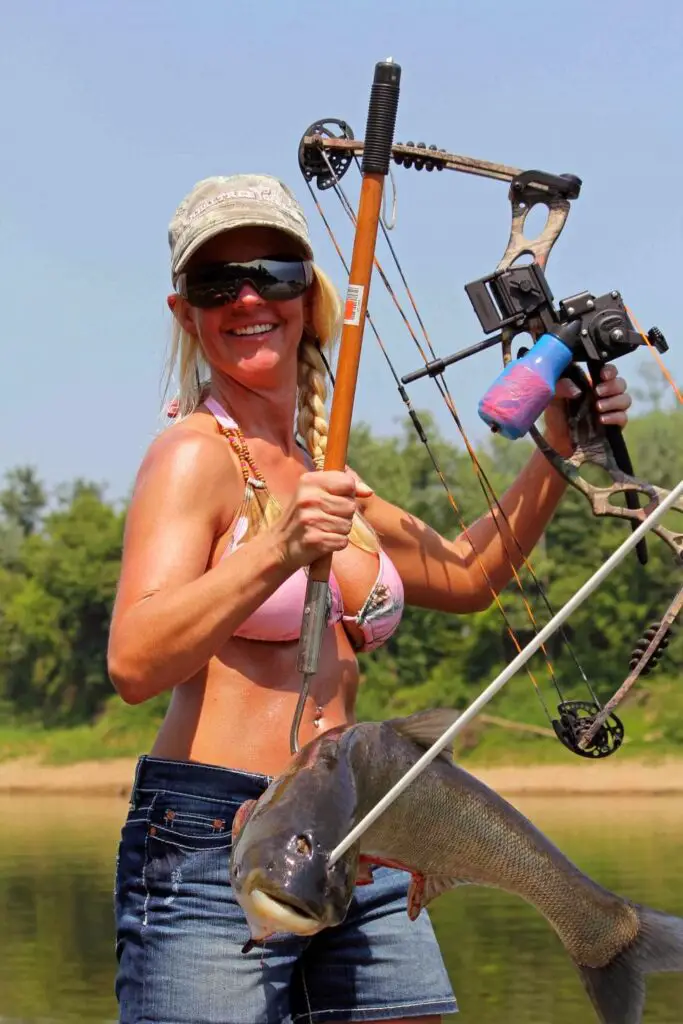
Image Credit: Flickr
If you are tired of traditional fishing techniques such as float fishing, try bow fishing instead. This is more a suggestion than advice, but I can tell you that it guarantees fun.
Carp are one of the most popular species among bow fishermen because they reside near the shore and in mid-level depth and can thus be aimed at accurately. Bow fishing is not easy though, especially when you are fishing from a boat or a kayak.
You need a lot of practice to learn how to aim. With a bit of experience and some muscle memory, you are bound to get better at it, catch a big carp, and have loads of fun!
If you want to see what bow fishing for carp looks like, watch this video:
FAQs
What attracts carp the most?
To attract carp the most, use boilies and fish attractors such as krill powder and liquids. You can also chum the water with some bread crumbs or sweet corn. Anglers often use coconut meal and yeast extracts, too.
What's the best time to catch carp?
The best time to catch carp is in the fall. As far as the time of the day is concerned, you should target carp either early in the morning or late in the afternoon.
How deep should I fish for carp?
You should fish for carp up to 30 feet deep. Even though carp can be caught in most depths, they prefer the lower and middle parts of the water column close to the shoreline.
What size hooks for carp?
You should use size 8, 6, or 4 hooks for carp. It depends on the size of the fish you are targeting and your desired casting distance. Ensure the shanks are long enough to hold your bait too.
Where do carp like to hang out in lakes?
Carp like to hang out in lakes around well-sheltered areas. So, find some snags, overhanging trees, or reed clumps along the bank and you will probably find them too. Carp can be at any depth, but they prefer the middle part of the water column.
Wrapping Up
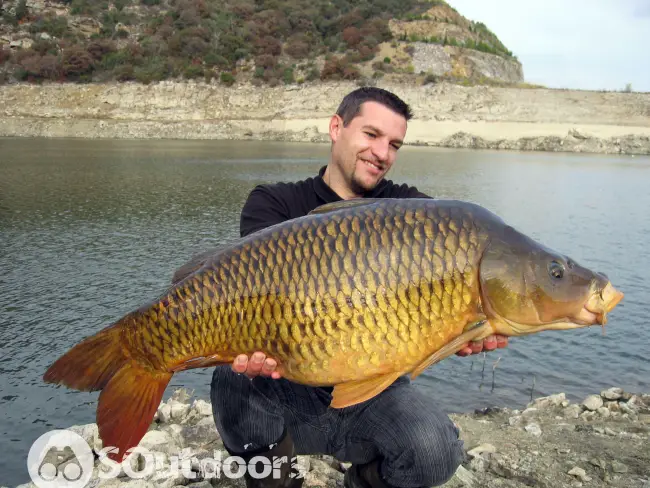
There you go! You now have all the priceless tips and tricks from experienced carp anglers at your disposal. I hope you will put it all to good use and catch yourself some trophy carp!
I hope I have inspired you to get out and pursue these amazing game fish. If you need anything, just leave a comment, and I’ll get back to you as soon as possible.

Thats one excellent photo, holding the carp above you head in the lake! how did you manage that?
Thanks, I only plunge into the water in some seconds. 🙂